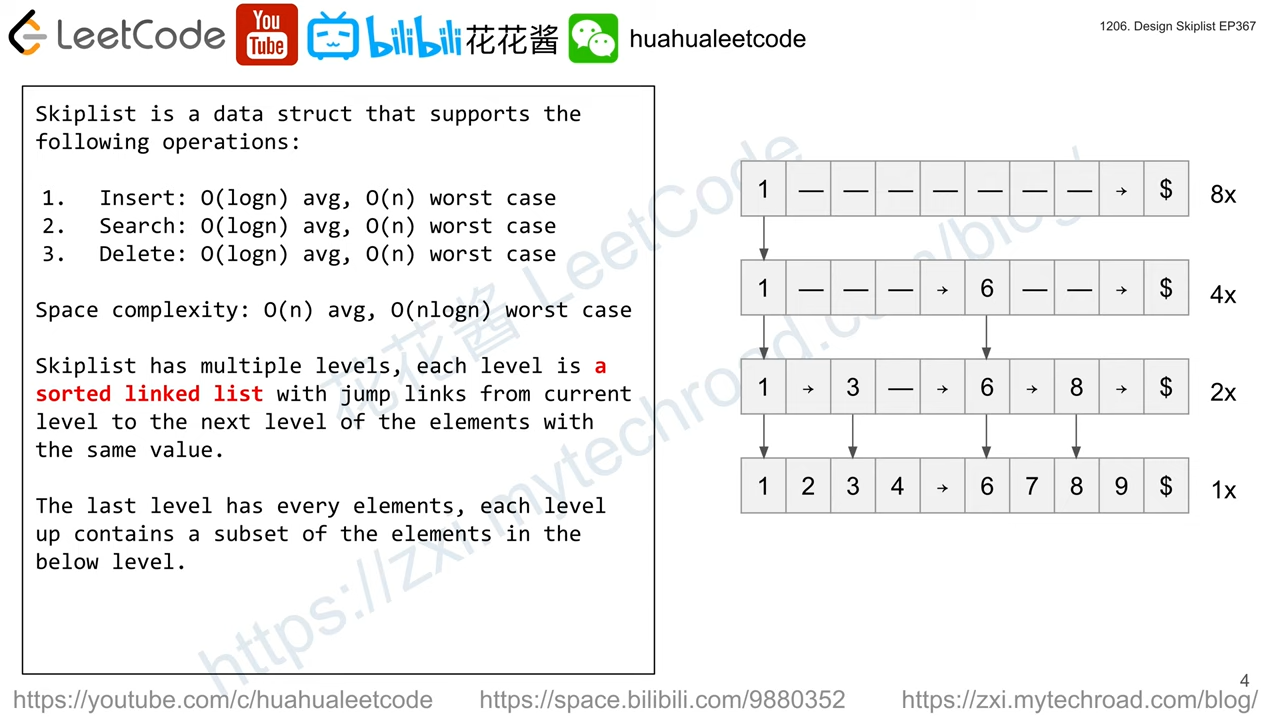Skip list(跳表)是一种以概率论为基础的线性数据结构。它可以说是有序链表的增强版。长得像这样:

支持:插入新数据、搜索某一数据、删除某一数据。
特点:
- 多层结构。每一层都是一个有序的链表。越上层数据越稀疏。最下层包含全部数据
- 对比有序链表:因为稀疏的上层数据,使得搜索速度变快了,因此插入、删除操作也变快了
- 仍然保留有序链表插入、删除新数据的开销小、不用像数组一样挪动全部数据的特点
理解 skip list 的关键点在于理解它是 如何生成新的 level 的。每当插入数据时,最下层(称之第一层)是一定必须插入的,之后第二层有 概率要插入,第三层有 ,第四层则是 ,依此类推。一旦有一层不再插入,则整个插入结束。因此假如现在只有 3 层,但是插入一个新数据时使得第 4 层也有了数据,就需要建新的一层出来。
编码时可用编程语言提供的随机库(如 Python 标准库中的 random)来做概率判断。注意的是:在判断每一层是否应该插入时,要注意概率判断时的累积问题(看下面代码实现中 random.getrandbits(1) 处的注释)。
花花酱的 Python 语言实现:
import random
class Node:
def __init__(self, val=-1, right=None, down=None):
self.val = val
self.right = right
self.down = down
class Skiplist:
def __init__(self):
self.head = Node() # Dummy head
def search(self, target: int) -> bool:
node = self.head
while node:
# Move to the right in the current level
while node.right and node.right.val < target:
node = node.right
if node.right and node.right.val == target:
return True
# Move to the the next level
node = node.down
return False
def add(self, num: int) -> None:
nodes = []
node = self.head
while node:
# Move to the right in the current level
while node.right and node.right.val < num:
node = node.right
nodes.append(node)
# Move to the next level
node = node.down
insert = True
down = None
while insert and nodes:
node = nodes.pop()
node.right = Node(num, node.right, down)
down = node.right
# 特别注意这一行:因为概率是会累积的,判断每一层是否要插入时,
# 只需要有 50% 概率就行(也就是 random.getrandbits(1) 的意义)。
insert = (random.getrandbits(1) == 0)
# Create a new level with a dummy head.
# right = None
# down = current head
if insert:
self.head = Node(-1, None, self.head)
def erase(self, num: int) -> bool:
node = self.head
found = False
while node:
# Move to the right in the current level
while node.right and node.right.val < num:
node = node.right
# Find the target node
if node.right and node.right.val == num:
# Delete by skipping
node.right = node.right.right
found = True
# Move to the next level
node = node.down
return found
# Your Skiplist object will be instantiated and called as such:
# obj = Skiplist()
# param_1 = obj.search(target)
# obj.add(num)
# param_3 = obj.erase(num)